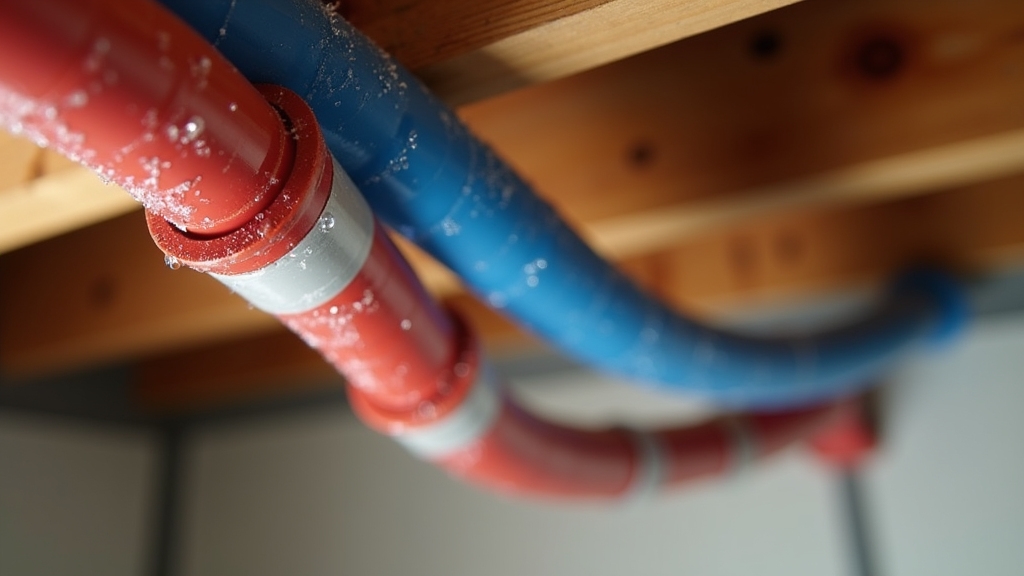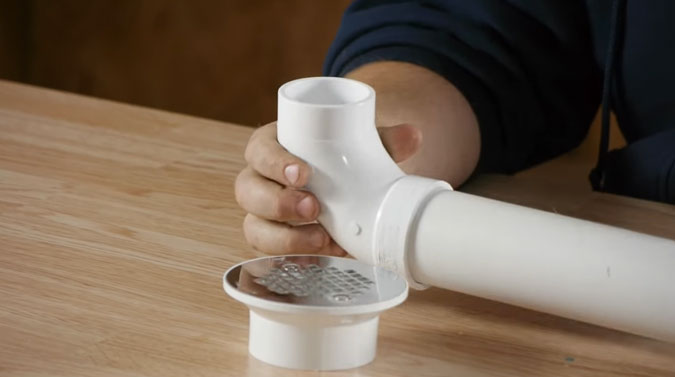You should insulate PEX pipes to maintain water temperature, boost energy efficiency, and prevent freezing, especially in cold or exposed areas. Insulation reduces heat loss and protects pipes from moisture and physical damage, extending their lifespan.
Using appropriate foam or rubber-based insulation and ensuring proper installation are key. Building codes often require insulation to meet thermal standards. To optimize performance and comply with regulations, understanding the best materials and installation practices is essential.
Key Takeaways
- Insulating PEX pipes reduces heat loss, improves energy efficiency, and lowers water heating costs.
- Insulation protects PEX pipes from freezing and damage in cold or exposed environments.
- Use flexible foam or rubber insulation with proper thickness to meet building codes and thermal requirements.
- Insulation extends pipe lifespan by shielding against moisture, temperature swings, and physical stress.
- Indoor PEX pipes in conditioned spaces may not require insulation, but it’s recommended for cold areas.
Importance of Insulating PEX Pipes

Although PEX pipes naturally reduce heat loss compared to metal pipes, insulating them markedly improves energy efficiency by maintaining consistent water temperatures and lowering heating system demands. Proper preparation for disassembly ensures that maintenance and repairs on piping systems can be performed safely and efficiently.
You’ll find that insulation cuts heat loss further, especially in long runs, which means your heating system works less and saves energy. It also protects pipes from freezing in cold conditions, preventing costly bursts. Insulated PEX includes an additional layer for improved heat retention, making it ideal for maintaining efficiency in outdoor or underground installations.
Insulation guards PEX against environmental stresses like ground moisture and temperature swings, extending pipe durability and service life. While insulating adds upfront costs, the energy savings and reduced maintenance often offset this expense over time.
Types of Insulation Suitable for PEX Tubing
You’ll find several insulation types suited for PEX tubing, including foam, fiberglass, rubber, and radiant barrier materials. Each offers specific benefits depending on your system’s temperature, moisture exposure, and installation environment.
Choosing the right insulation requires matching material properties and thickness to your pipe size and performance needs. Proper insulation can also reduce thermal losses and protect the piping from mechanical stress and environmental factors.
Selecting the right insulation depends on environment, budget, and performance needs, ensuring optimal protection and efficiency for your PEX system.
Common Insulation Materials
What insulation materials work best for PEX tubing depends on your specific needs and installation environment.
Foam pipe insulation, made from polyethylene or rubber-based foam, is flexible, lightweight, and cost-effective. It’s ideal for cold and low-temperature pipes. This type of insulation also helps in minimizing heat loss to maintain fluid temperatures effectively.
Rubber insulation offers high flexibility, moisture resistance, and a good fire rating. It’s suitable for both hot and cold lines, including areas prone to condensation and noise.
Fiberglass insulation provides excellent thermal performance, especially in cold, stable environments. However, it’s less flexible and more costly compared to foam or rubber options.
For bundled PEX systems, specialized closed-cell foam with radiant foil layers enhances insulation and mechanical protection. Corrugated outer materials like HDPE, PVC, or polypropylene don’t insulate but provide mechanical protection.
Each material suits different scenarios, balancing cost, durability, flexibility, and thermal efficiency for optimal PEX pipe performance.
Choosing Proper Insulation
How do you select the right insulation for PEX tubing? Focus on meeting code requirements and thermal needs based on your application environment—indoor, outdoor, or buried. Consider the impact of environmental conditions on insulation effectiveness to ensure durable protection.
Choose insulation types that provide adequate R-values (generally R-2 to R-6) for protection and efficiency. Consider moisture resistance and ease of installation to ensure long-lasting performance. Use waterproof pipe insulation to prevent heat loss and leaks, especially in outdoor or underground applications.
| Insulation Type | Key Features |
|---|---|
| Foam (Split or Solid) | Easy retrofit; moderate R-value |
| Rubber | High moisture resistance; durable |
| Radiant Barrier | Superior heat reflection; flexible |
Match insulation thickness to pipe diameter and verify local codes before installation. Proper insulation prevents freezing and reduces heat loss. This ensures PEX systems perform reliably and efficiently regardless of location or climate.
Energy Efficiency Benefits of PEX Pipe Insulation

Why does insulating PEX pipes matter for energy efficiency? Insulation markedly reduces heat loss by maintaining higher water temperatures inside hot water pipes.
This improved heat retention lowers energy demand on your water heating system, cutting utility bills and enhancing overall system efficiency, especially in radiant floor heating setups. Proper insulation also helps prevent overheating issues common in water systems that can arise from operating beyond design limits.
Even though PEX pipes inherently retain heat better than metal, insulation further minimizes thermal conductivity. By keeping hot water at desired temperatures longer, insulation reduces reheating needs and standby heat loss in hidden piping.
The cross-linked polyethylene material of PEX adds durability that complements insulation benefits by maintaining performance under extreme temperature conditions. This leads to shorter wait times at fixtures, conserving water and energy.
Additionally, insulation supports consistent heat transfer, lowers operational costs, and lessens environmental impact by reducing energy consumption and greenhouse gas emissions across diverse climates.
Protecting PEX Pipes From Freeze Damage
Insulating PEX pipes not only boosts energy efficiency but also plays a significant role in protecting them from freeze damage.
When temperatures drop to 32°F (0°C), water inside pipes freezes, expanding about 9% and increasing internal pressure. It is important to check the valve on heating systems connected to PEX pipes to prevent leaks caused by freeze damage.
Though PEX pipes flex and can expand, repeated freezing weakens them, leading to leaks or failure. PEX pipes are resistant to corrosion and have a lifespan rated for up to 100 years. To reduce freeze risk, insulate pipes in cold or exposed areas with foam or flexible materials.
Guarantee underground pipes are buried below the frost line, typically 36–48 inches deep. Maintain indoor temperatures above 55°F (13°C) and allow faucets to drip during extreme cold to keep water moving.
Installation Tips for PEX Pipe Insulation
Before you begin installing insulation on PEX pipes, make sure to measure the full length of each pipe accurately. Cut the insulation slightly longer to guarantee complete coverage.
Clean and dry the pipe surface thoroughly to ensure good adhesion and prevent mold growth. Inspect the pipes to remove any moisture or dirt before applying insulation. Proper insulation reduces heat loss and helps prevent freezing, enhancing the system’s efficiency and durability.
This is especially important to avoid issues like freezing pipes that can lead to pressure loss. Use flexible insulation materials that can easily wrap around the pipes. Leave small gaps at joints to accommodate pipe expansion and contraction.
Secure the insulation with tape or zip ties, but avoid compressing it. This preserves the insulation’s R-value and ensures effective thermal protection.
| Step | Action | Tip |
|---|---|---|
| Measure & Cut | Use tape measure, cut longer | Straight cuts ensure fit |
| Prepare Pipe | Clean, dry, inspect | Remove moisture/dirt |
| Secure Insulation | Tape or zip ties, seal seams | Avoid over-tightening |
Compliance With Building and Energy Codes for PEX Insulation
Proper installation of PEX pipe insulation doesn’t end with fitting the material correctly; you also need to guarantee the work complies with building and energy codes. PEX is recognized by the International Residential Code (IRC), which mandates proper support per P2605.1 and third-party certification under NSF 14.
Ensuring PEX pipe insulation meets IRC standards and NSF 14 certification is crucial for code compliance. Insulation requirements depend on pipe function and match copper standards because PEX lacks inherent thermal protection.
You must apply minimum insulation thicknesses as specified in the 2012 IECC, adjusting for pipe size, fluid temperature, and location. It is important to monitor the pump when testing new installations to ensure consistent performance.
In cold climates, insulation or heat tracing is mandatory near exterior walls and below the frost line to prevent freezing. Additionally, protect insulation from sunlight, moisture, and physical damage using appropriate covers.
However, in conditioned spaces inside homes, such as utility closets or interior walls, PEX typically does not require additional insulation as these areas are generally protected from freezing temperatures conditioned space protection.
Frequently Asked Questions
Can PEX Pipes Be Insulated With Recycled Materials?
Yes, you can insulate PEX pipes with recycled materials like foam made from recycled polyethylene, fiberglass containing recycled content, or rubber with recycled compounds.
Just guarantee the insulation meets the required R-value and is compatible with PEX to avoid moisture issues or pipe damage. Be mindful of installation complexity and local code requirements.
Choosing the right recycled insulation helps maintain energy efficiency and freeze protection while supporting sustainability goals.
How Does Insulation Affect Water Pressure in PEX Pipes?
Think of insulation as a shield that keeps temperature swings from throwing your water pressure off balance. Insulation doesn’t directly change water pressure inside PEX pipes, but by preventing freezing, it stops pressure spikes caused by expanding ice.
This means less risk of bursts or leaks. So, while insulation won’t pump up your pressure, it keeps it steady by guarding against temperature-induced pressure surges that stress your piping system.
Is Insulation Necessary for PEX Pipes in Warm Climates?
Insulation isn’t strictly necessary for PEX pipes in warm climates, but it’s still beneficial. You’ll reduce heat loss in hot water lines, improving efficiency and cutting energy costs.
Plus, insulation prevents condensation on cold lines, avoiding mold and water damage. While freeze protection is less critical, insulation extends pipe life and guards against occasional cold snaps.
Evaluate your usage and environment to decide if the upfront cost makes sense for you.
Can Insulated PEX Pipes Be Used Outdoors Without Additional Protection?
You might imagine insulated PEX pipes lounging outside in a sun hat, sipping a drink, fully protected. But in reality, while these pipes come with high-density insulation and waterproof jackets, you shouldn’t omit extra protection.
Soil pressure, sharp debris, and extreme cold demand proper burial depth, sand cushioning, and sometimes additional insulation. Therefore, don’t trust the pipe’s fancy jacket alone—take the necessary precautions to ensure durability and prevent freezing outdoors.
What Is the Lifespan of Insulation Materials on PEX Pipes?
You can expect insulation materials on PEX pipes to last between 10 and 30 years, depending on the type you use and environmental conditions. Closed-cell foam generally lasts longer than fiberglass, especially if protected from UV exposure and physical damage.
To extend lifespan, install insulation properly, shield it from sunlight, and inspect it annually. Replace any cracked or hardened insulation promptly to maintain energy efficiency and prevent pipe damage.
Foam vs Rubber: Choosing the Right Insulation Material for PEX Pipes
Insulating your PEX pipes isn’t just a good idea—it’s essential. Studies show that properly insulated pipes can reduce heat loss by up to 30%, improving energy efficiency and cutting costs.
Plus, insulation protects against freeze damage, extending your system’s lifespan. Use foam or rubber sleeves for best results, and always follow local codes to guarantee compliance. Taking these simple steps helps you maintain a reliable, efficient plumbing system year-round.


